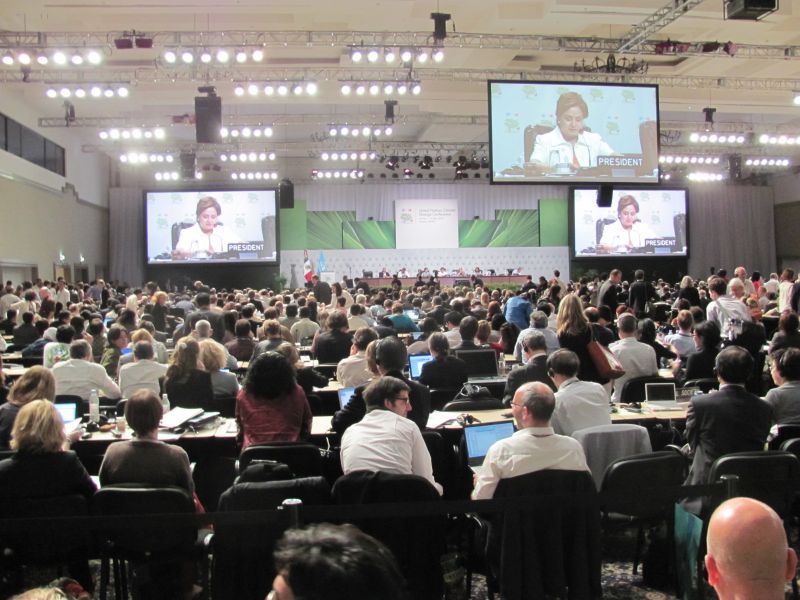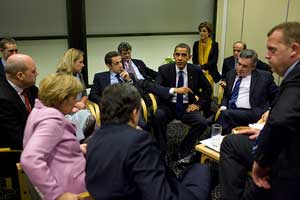I penned a wrap-up report on the Cancun climate talks in the wee hours of Saturday morning, just before rushing to catch a flight back to the US. Now I’ve had some time to ponder the agreement.
In short, nearly everyone acknowledges that the broad goals nations agreed to in Cancun, which largely mirror those outlined in the Copenhagen accord, fall far short of what is actually needed to avert disastrous impacts of climate change. While leaders have, on paper, committed to limiting warming to 2 degrees Celsius (3.6 degrees Fahrenheit), the pledges so far won’t meet that. Instead, they leave the world on a path to a temperature rise of 3 to 3.9 degrees Celsius—dangerously high for the most vulnerable regions of the world. Meanwhile, small island states and other vulnerable nations are still arguing that 2 degrees is already too much; leaders should aim for 1.5 degrees.
The Cancun agreements also leave some of the thorniest questions about the legal status of international climate deals unanswered. Whether industrialized nations will extend the life of the Kyoto Protocol (excluding, of course, the US, which never ratified it) was a major subject of disagreement at COP16. Japan and Russia said no way, while developing nations have stood firm that dropping the only legally binding instrument to curb emissions would be a deal-breaker for them. There was really no resolution on that issue in Cancun; instead, it was punted to next year’s meeting in Durban, South Africa—even closer to the looming 2012 expiration date for the first commitment period for Kyoto. The debate probably isn’t going to get any easier in the next 12 months.
I think Sivan Kartha of the Stockholm Environment Institute put it best when he noted that it’s not yet clear whether the one-year delay will serve as “a lifeline or a noose” for Kyoto. Unless something changes significantly in the next year, it sure looks to me like the latter. This is largely because there’s no real sense yet of where the separate track of negotiations, the one that would bring the US and China, into an agreement is heading in terms of its legal form. As many times as US climate envoy Todd Stern has insisted that the US doesn’t have a say on Kyoto, it really does—if only because the tension around it is the fact that there’s very little faith globally that the US is going to pass a new domestic climate law and/or ratify a treaty for at least another two years (if ever). So until the legal path of a new agreement takes shape, the fate of Kyoto will continue to plague negotiators.
That said, the outcome in Cancun was, I think, as positive as it could have been given the scaled back expectations. Negotiators accomplished what they set out to at the summit, and 193 of the 194 countries there left satisfied—or at least as satisfied as anyone really can be when you’re trying to reach global consensus. But more than the outcome, it was heartening to see negotiators actually happy with the process, especially after the muddled end to the Copenhagen climate talks a year ago. Sure, President Obama and a small group of leaders were able to hash out a deal last year that largely serves as the basis for the Cancun agreement. But it ended in utter chaos—with countries feeling betrayed and shut out, and the body unable to formally adopt the deal. Contrast that to the multiple rounds of standing ovations that the Mexican presidency received Friday night and into Saturday morning and the near-unanimous agreement on adopting the package.
The cheers were more for the process than the substance, but that means something in the context of these climate summits. It’s really, really difficult to get the countries of the world to agree to anything. Doing so takes masterful mediators, trust among the parties, and it takes time—probably more time than the pace of climate change really allows us, unfortunately.
I’ll have a few more posts in the coming days about specific portions of the Cancun agreement. In the meantime, here are a few other perspectives.
Here’s Lisa Friedman reporting for ClimateWire:
Throughout the halls, the mood was a mixture of jubilation and relief. Few cast the Cancun Agreements as major step forward, but most said it did repair the damage done to the U.N. climate negotiations by the chaotic and contentious meeting last year in Copenhagen, Denmark.
“We’ve definitely exorcised the ghost of Copenhagen,” said Alden Meyer, director of policy and strategy for the Union of Concerned Scientists, as he hopped back on crutches from the Moon Palace after the initial vote.
“The emotion is a little ahead of the substance, but that’s OK. It’s a good night,” Meyer said. Angela Anderson, director of the Climate Action Network, called it a Copenhagen “do-over.”
Here’s what Brad Johnson, of the Center for American Progress’s Wonk Room, had to say:
The first lesson of the Cancun talks is that the governments of the world can in fact work together on global warming, even though decoupling civilization from greenhouse pollution is a herculean task. However, the second lesson is that their leadership only gets humanity so far. Only the full mobilization of the present generation can overcome the institutional barriers to change and protect our fragile civilization from the raging climate system our pollution has created. The Cancun compact has restored hope around the world, but now the actual work has to begin.
“It represents a set of modest steps forward,” writes Robert N. Stavins, director of the Harvard Environmental Economics Program. “Nothing more should be expected from this process.”
And here’s Michael Levi of the Council on Foreign Relations: “Politically, it takes what was a toxic agreement and obtains much more solid buy-in from the most important parties.”














